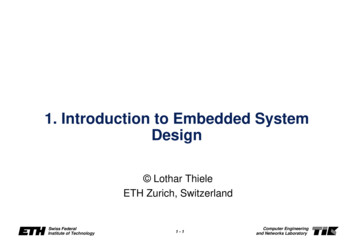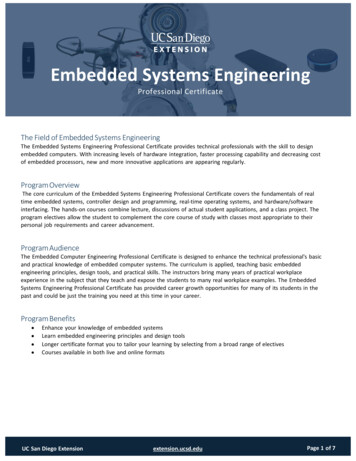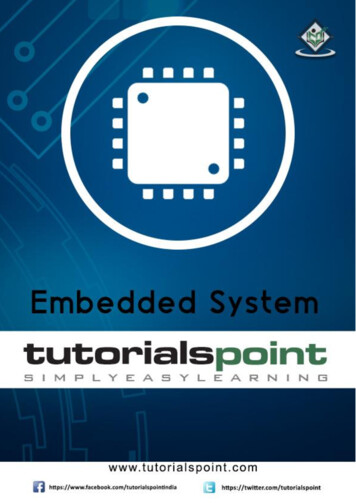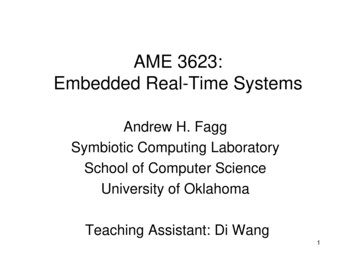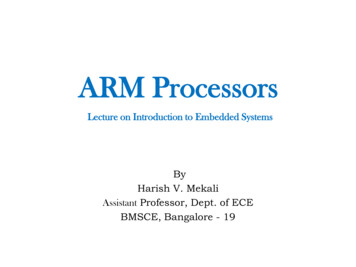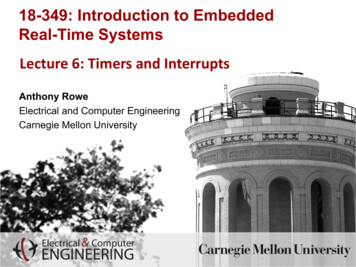
Transcription
18-349: Introduction to EmbeddedReal-Time SystemsLecture 6: Timers and InterruptsAnthony RoweElectrical and Computer EngineeringCarnegie Mellon UniversityEmbedded Real-Time Systems
Embedded Real-Time SystemsLecture Overview§ Timers§ Interrupts§ Interrupt Latency§ Interrupt Handlers§ Concurrency issues with interrupt handlers2
Embedded Real-Time SystemsWhat is a Timer?§ A device that uses a highspeed clock input to provide a series oftime or count-related eventsCounter RegisterSystem Clock0x1206Reloadon Zero Clock Divider000000Countdown RegisterInterrupt toProcessorI/O Control
Embedded Real-Time SystemsUses of Timers§ Pause Function§ Suspends task for a specifiedamount of time§ One-shot timer§ Single one-time-only timeout§ Periodic timer§ Multiple renewable timeouts§ Time-slicing§ Chunks of time to each task§ Watchdog timer
Embedded Real-Time SystemsWatchdog Timers A piece of hardware that can be used to reset the processor incase of anomalies Typically a timer that counts to zero– Reboots the system if counter reaches zero– For normal operation – the software has to ensure that the counter neverreaches zero (“kicking the dog”)
Embedded Real-Time SystemsCare of Your Watchdog§A watchdog can get the system out of many dangerous situations§But, be very careful§ Bugs in the watchdog timer could perform unnecessary resets§ Bugs in the application code could perform resets§Choosing the right kicking interval is important§ System initialization process is usually lengthy§ Some watchdogs can wait longer for the first kick than for the subsequentkicks§ What should you do, for example, if some functions in a for loop cantake longer than the maximum timer interval?
Embedded Real-Time SystemsInterruptsMerriam-Webster:§ “to break the uniformity or continuity of”§ Informs a program of some external events§ Breaks execution flowKey questions:§ Where do interrupts come from?§ How do we save state for later continuation?§ How can we ignore interrupts?§ How can we prioritize interrupts?§ How can we share interrupts?7
Embedded Real-Time SystemsInterruptsInterrupt (a.k.a. exception or trap): An event that causes the CPU to stop executing current program Begin executing a special piece of code Called an interrupt handler or interrupt service routine (ISR) Typically, the ISR does some work Then resumes the interrupted programInterrupts are really glorified procedure calls, except that they: can occur between any two instructions are “transparent” to the running program (usually) are not explicitly requested by the program (typically) call a procedure at an address determined by the type of interrupt, notthe program
Embedded Real-Time SystemsTwo basic types of interrupts (1/2)§ Those caused by an instruction§ Examples:§ TLB miss§ Illegal/unimplemented instruction§ div by 0§ SVC (supervisor call, e.g.: SVC #3)§ Names:§ Trap, exception
Embedded Real-Time SystemsTwo basic types of interrupts (2/2)§ Those caused by the external world§§§§§External deviceReset buttonTimer expiresPower failureSystem error§ Names:§ interrupt, external interrupt
Embedded Real-Time SystemsHow it works§§§§Something tells the processor core there is an interruptCore transfers control to code that needs to be executedSaid code “returns” to old programMuch harder then it looks.§ Why?
Embedded Real-Time SystemsDevil is in the details§ How do you figure out where to branch to?§ How to you ensure that you can get back to where you started?§ Don’t we have a pipeline? What about partially executedinstructions?§ What if we get an interrupt while we are processing our interrupt?§ What if we are in a “critical section?”
Embedded Real-Time SystemsInterrupt vs. Polled I/O§ Polled I/O requires the CPU to ask a device (e.g. Ethernet controller)if the device requires servicing§ For example, if the Ethernet controller has changed status orreceived packets§ Software plans for polling the devices and is written to knowwhen a device will be serviced§ Interrupt I/O allows the device to interrupt the processor, announcingthat the device requires attention§ This allows the CPU to ignore devices unless they requestservicing (via interrupts)§ Software cannot plan for an interrupt because interrupts canhappen at any time therefore, software has no idea when aninterrupt will occur§ Processors can be programmed to ignore or mask interrupts§ Different types of interrupts can be masked (IRQ vs. FIQ)
Embedded Real-Time SystemsPolling vs. InterruptDriven I/O§ Polling requires code to loop until device is ready§ Consumes lots of CPU cycles§ Can provide quick response (guaranteed delay)§ Interrupts don't require code to loop until the device is ready§ Device interrupts processor when it needs attention§ Code can go off and do other things§ Interrupts can happen at any time§ Requires careful coding to make sure other programs (or your own)don't get messed up§ What do you think real-time embedded systems use?
Embedded Real-Time SystemsOnto IRQs & FIQs: Interrupt HandlerstimeTaskIRQuser programuser programIRQ Interrupt handlerFIQInterrupt On interrupt, the processor will set thecorresponding interrupt bit in the cpsrto disable subsequent interrupts of thesame type from occurring. However, interrupts of a higher prioritycan still occur.
Embedded Real-Time SystemsTiming Issues in Interrupts§ Before an interrupt handler can do anything, it must save away the currentprogram's registers (if it touches those registers)§ That's why the FIQ has lots of extra registers, to minimize CPU contextsaving overheadtimeTaskuser programCPU context saveduser programIRQ“servicing” interruptFIQCPU context restoredInterruptInterrupt latency
Embedded Real-Time SystemsServicing FIQs Within IRQ§ Interrupts can occur within interrupt handlerstimeTaskIRQuser programuser programIRQ Interrupt handlerFIQ Interrupt handlerFIQInterruptSecondInterrupt
Embedded Real-Time Systemscpsr & spsr for IRQs and FIQs3128N Z CV§ Interrupt Disable bits§ I 1, disables the IRQ§ F 1, disables the FIQ§ Mode bits§ Processor mode differs48I F0Mode
Embedded Real-Time SystemsException PrioritiesI bitF bit(1aIRQ Disabled)(1aFIQ Disabled)1 (highest)11Data Abort21Fast InterruptRequest (FIQ)31Interrupt Request(IRQ)41Prefetch Abort51Software Interrupt616 ty1
How are FIQs Faster?§ FIQs are faster than IRQs in terms of interruptlatency§ FIQ mode has five extra registers at its disposal§ No need to save registers r8 – r12§ These registers are banked in FIQ mode§ Convenient to store status between calls to thehandler§ FIQ vector is the last entry in the vector table§ The FIQ handler can be placed directly at thevector location and run sequentially startingfrom that location§ Cache-based systems: Vector table FIQhandler all locked down into one blockUserEmbedded Real-Time SystemsFIQIRQ
Embedded Real-Time SystemsIRQ and FIQ ISR HandlingIRQ HandlingWhen an IRQ occurs, the processor––Copies cpsr into spsr irqSets appropriate cpsr bits –––Sets mode field bits to 10010Disables further IRQsMaps in appropriate banked registersStores the address of “next instruction 4” in lr irqSets pc to vector address 0x00000018To return, exception handler needs to:– Restore cpsr from spsr irq– Restore pc from lr irq– Return to user modeFIQ HandlingWhen an FIQ occurs, the processor- Copies cpsr into spsr fiq- Sets appropriate cpsr bits Sets mode field bits to 10001Disables further IRQs and FIQs- Maps in appropriate banked registers- Stores the “next instruction 4” in lr fiq- Sets pc to vector address 0x0000001c0To return, exception handler needs to:- Restore cpsr from spsr fiq- Restore pc from lr fiq- Return to user mode
Embedded Real-Time SystemsInterrupt al PortSPI
Embedded Real-Time SystemsJumping to the Interrupt Handler§ Non-vectored§ Processor jumps to the same location irrespective of the kind ofinterrupt§ Hardware simplification§ Vectored§ Device supplies processor with address of interrupt service routine§ Interrupt handler reads the address of the interrupt service routinefrom a special bus§ Why the different methods?§ If multiple devices uses the same interrupt the processor must polleach device to determine which device interrupted the processor§ This can be time-consuming if there is a lot of devices§ In a vectored system, the processor would just take the addressfrom the device (which dumps the interrupt vector onto a specialbus).
Embedded Real-Time SystemsJumping to the Interrupt Handler§ Auto-vectored§ Multiple CPU interrupt inputs for interrupts of different prioritylevel§ ARM has two – FIQ and IRQ§ Other processors, like 68000, SPARC, may have 8 or more§ Processor-determines address of interrupt service routine basedon type of interrupt§ For ARM, pseudo-auto vectored IRQs and FIQs is implementedusing an on-chip interrupt controller
Embedded Real-Time SystemsTypes of Interrupt Handlers§ Non-nested interrupt handler (simplest possible)§ Services individual interrupts sequentially, one interrupt at a time§ Nested interrupt handler§ Handles multiple interrupts without priority assignment§ Prioritized (re-entrant) interrupt handler§ Handles multiple interrupts that can be prioritized
Embedded Real-Time SystemsNon-Nested Interrupt Handler§ Does not handle any further interrupts until the current interrupt isserviced and control returns to the interrupted task§ Not suitable for embedded systems where interrupts have varyingpriorities and where interrupt latency matters§ However, relatively easy to implement and debug§ Inside the ISR (after the processor has disabled interrupts, copiedcpsr into spsr mode, set the etc.)§ Save context – subset of the current processor mode’s nonbankedregisters§ Not necessary to save the spsr mode – why?§ ISR identifies the external interrupt source – how?§ Service the interrupt source and reset the interrupt§ Restore context§ Restore cpsr and pc
Embedded Real-Time SystemsNested Interrupt Handler§ Allows for another interrupt to occur within the currently executinghandler§ By re-enabling interrupts at a safe point before ISR finishes servicingthe current interrupt§Care needs to be taken in the implementation§ Protect context saving/restoration from interruption§ Check stack§ Increases code complexity, but improves interrupt latency§ Does not distinguish between high and low priority interrupts§ Time taken to service an interrupt can be high for high-priority interrupts27
Embedded Real-Time SystemsPrioritized (Re-entrant) Interrupt Handler§ Allows for higher-priority interrupts to occur within the currentlyexecuting handler§ By re-enabling higher-priority interrupts within the handler§ By disabling all interrupts of lower priority within the handler§Same care needs to be taken in the implementation§ Protect context saving/restoration from interruption, check stack overflow§ Does distinguish between high and low priority interrupts§ Interrupt latency can be better for high-priority interrupts28
Embedded Real-Time SystemsInterrupts and Stacks§ Stacks are important in interrupt handling§ Especially in handling nested interrupts§ Who sets up the IRQ and FIQ stacks and when?§ Stack size depends on the type of ISR§ Nested ISRs require more memory space§ Stack grows in size with the number of nested interrupts§ Good stack design avoids stack overflow (where stack extends beyondits allocated memory) – two common methods§ Memory protection§ Call stack-check function at the start of each routine§ Important in embedded systems to know the stack size ahead of time(as a part of the designing the application) – why?29
Embedded Real-Time SystemsResource Sharing Across Interrupts§ Interrupts can occur asynchronously§ Access to shared resources and global variables must be handled ina way that does not corrupt the program§ Normally done by masking interrupts before accessing shared dataand unmasking interrupts (if needed) afterwards§ Clearly, when interrupt-masking occurs, interrupt latency will be higher§ Up next – start with a simple keyboard ISR and then understand§ What can happen when the ISR takes a while to execute§ How do we improve its interrupt latency§ What can go wrong30
Embedded Real-Time SystemsStarting With a Simple Example§ Keyboard command processingThe “B” key is pressed by the userThe “keyboard” interrupts the processor31What happens if anotherkey is pressed or if a timerinterrupt occurs?Jump to keyboard ISR (non-nested)keyboard ISR() {ch Read keyboard input registerHow long does thisswitch (ch) {processing take?case ‘b’ : startApp(); break;case ‘x’ : doSomeProcessing(); break;.}return from ISR}
Embedded Real-Time SystemsImproving Interrupt Latency§ Add a buffer (in software or hardware) for input characters.32§ This decouples the time for processing from the time betweenkeystrokes, and provides a computable upper bound on the timerequired to service a keyboard interrupt§ Commands stored in the input buffer can be processed in theuser/application codeA key is pressed by the userThe “keyboard” interrupts the processorJump to keyboard ISRkeyboard ISR() {*input buffer ch;.}return from ISRStores the input and then quicklyreturns to the “main program”(process) Application Code while (!quit){if (*input buffer){processCommand(*input buffer);removeCommand(input buffer);}}
Embedded Real-Time SystemsWhat Can Go Wrong? Buffer Processing33keyboard ISR(){ch Read ACIA input register*input buffer ch;}return from ISRWhat happens if another commandis entered as you remove one fromthe inputBuffer?application code while (!quit){if (*input buffer){processCommand(*input buffer);removeCommand(input buffer);}}
Embedded Real-Time SystemsAnother Concurrency Problem§ An application uses the serial port to print characters on the terminalemulator (Hyper Terminal)§ The application calls a function PrintStr to print characters to the terminal§ In the function PrintStr, the characters to be printed are copied into an outputbuffer (use of output buffer to reduce interrupt latency)§ In the serial port ISR§ See if there is any data to be printed (whether there are new characters in theoutput buffer)§ Copy data from the output buffer to the transmit holding register of the UART§ The (new app) display also needs to print the current time on theterminal – a timer is used (in interrupt mode) to keep track of time§ In the timer ISR§ Compute current time§ Call PrintStr to print current time on the terminal emulator
Embedded Real-Time SystemsAnother Example:Buffer for Printing Chars to Screen35PrintStr(“this is a line”);PrintStr(*string)char *string;{while (*string) {outputBuffer[tail ] *string ;}}T H I SI Stail points here and a timer interrupt occursJump to timer ISRtimer ISR(){clockTicks ;PrintStr(convert(clockTicks));}T H I SI S2 : 3 0
Embedded Real-Time SystemsCritical Sections of Code§ Pieces of code that must appear as an atomic action36printStr(*string)char *string;printStr(“this is a line”);{MaskInterrupts();while (*string){outputBuffer[tail ] *string ;}UnmaskInterrupts();tail points here and a timer interrupt occurs}T H I SI SJump to timer ISR happens after printStr() completestimer ISR(){clockTicks ;printStr(convert(clockTicks));}T H I SI SAL I N EAtomic actionaction that“appears”'to take place in asingle indivisibleoperation
Embedded Real-Time SystemsShared-Data Problems§ Previous examples show what can go wrong when data is sharedbetween ISRs and application tasks§ Very hard to find, and debug such concurrency problems (if theyexist)§ Problem may not happen every time the code runs§ In the previous example, you may not have noticed the problem ifthe timer interrupt did not occur in the PrintStr function§ Lessons learned§ Keep the ISRs short§ Analyze your code carefully, if any data is shared between ISRs andapplication code37
Embedded Real-Time SystemsSummary§ Timers§ Interrupts§ Interrupt Latency§ Interrupt Handlers§ Concurrency issues with interrupt handlers§ Next Lecture: ARM Optimization (NOT SWI and the Kernel)38
Embedded Real-Time Systems Non-Nested Interrupt Handler § Does not handle any further interrupts until the current interrupt is serviced and control returns to the interrupted task § Not suitable for embedded systems where interrupts have varying priorities and where interrupt latency





